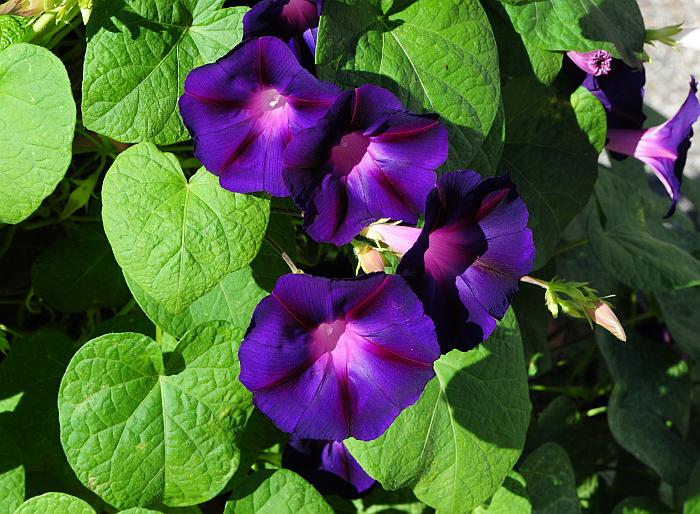Ipomoea purpurea (L.) Roth
Common Morning Glory

Introduced
CC = *
CW = 5
MOC = 26
© SRTurner
Ipomoea purpurea (L.) RothCommon Morning Glory | |
 |
Introduced CC = * CW = 5 MOC = 26 |
© SRTurner |
|
Family - Convolvulaceae Habit - Annual forb. Stems - Scrambing or twining in other vegetation, to 4 m, moderately to densely pubescent with relatively long, spreading to downward-angled hairs.
Leaves - Alternate, simple, entire, long-petiolate. Blades 2-12 cm long, unlobed or less commonly deeply 3-lobed, the lobes triangular, broadly ovate to ovate-triangular, tapered to a sharply pointed tip, shallowly to more commonly deeply cordate at the base, both surfaces moderately pubescent with straight, appressed to spreading hairs.
Inflorescence - Axillary, the flowers solitary or in loose clusters, long-stalked.
Flowers - Stalks moderately to densely pubescent with relatively long, spreading to downward-angled hairs. Sepals sometimes with the outer 2 slightly longer and broader than the inner ones, 10-17 mm long, oblong-lanceolate or narrowly oblong, narrowed or short-tapered to a sharply pointed, somewhat outward-curved, triangular tip, the surface and margins moderately to densely pubescent with relatively long, spreading to downward-angled hairs. Corollas 2.5-5.0 cm long, funnelform, the tube widened gradually toward the tip, pink, purple, or less commonly white or light blue with a white or yellowish white center. Stamens not exserted. Ovary 3-locular, the stigma 3-lobed.
Fruits - Globose capsules, the main body 8-10 mm long, the persistent style 2-5 mm long, glabrous. Seeds 3.8-4.5 mm long, the surface moderately to densely minutely hairy. Flowering - July - October. Habitat - Streambanks, fields, gardens, ditches, railroads, roadsides, and open, disturbed areas. Origin - Native to tropical America. Lookalikes - I. hederacea. Other info. - This striking vine occurs in widely scattered locations across Missouri as well as most of the continental U.S. It is much less common in the wild than its sibling I. hederacea, at least in Missouri. The two are similar in appearance, but can be reliably differentiated by the sepals. In I. hederacea these are long and very narrow, whereas in I. purpurea they are shorter and more triangular in shape. In addition, the leaves of I. purpurea are usually unlobed, although this character must be used cautiously. The color of the flower is not taxonomically meaningful. Photographs taken in Brown Summit, NC., 8-6-02 (DETenaglia); also in Washington, Franklin County, MO, 10-4-2019; and at Don Robinson State Park, Jefferson County, MO, 8-10-2024 (SRTurner). |